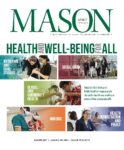Mason researcher Alessandra Luchini is brilliant. No, really—it’s been confirmed by Popular Science, one of the country’s largest science magazines.
In its October issue, the magazine annually names the top scientists under the age of 40, whom they dub the “Brilliant 10.” Luchini learned last summer that she had been selected for her work with Mason’s Center for Applied Proteomics and Molecular Medicine (CAPMM).
In 2008, Luchini and a team of CAPMM researchers introduced an innovative technology, a nanoparticle, that looks at specific protein biomarkers in blood or urine in order to improve the diagnosis and treatment of cancer and other diseases.
This nanoparticle captures, concentrates, and preserves cancer and other disease markers in a single step. They are added to blood or urine to catch these disease biomarkers, similar to how a lobster trap catches lobsters.
Luchini’s breakthrough technology, which is still in the research and development phase, has been used in several different clinical tests over the past few years, and the results are promising.
“Dr. Luchini’s nanoparticles have revolutionary potential to improve the diagnosis of early-stage cancer and infectious disease,” says Lance Liotta, codirector of CAPMM who nominated Luchini for the award. “This could reduce suffering and death for millions.”
Discovering New Biomarkers
Luchini originally came to Mason on a fellowship sponsored by the Istituto Superiore di Sanità (the Italian equivalent of the National Institutes of Health [NIH]), which continues to support her research. The nanoparticle projects are funded by NIH’s National Cancer Institute and National Institute of Arthritis and Musculoskeletal and Skin Diseases.
Luchini’s discovery is licensed under the name “Nanotrap” through Ceres Nanoscience, a Mason spin-off company launched to promote university-based inventions. Luchini, as codirector of science at Ceres, has overseen the use of this technology by several other research facilities as a way to discover molecules in body fluids.
This invention has enabled the discovery of a plethora of new biomarkers, which were not detectable before because of their low concentration and unstable nature.
“The nanoparticles that Dr. Luchini developed both solve and overcome many of the technical barriers that have prohibited biomarker discovery,” explains Emanuel Petricoin III, who directs CAPMM with Liotta. “Now, armed with this technology, we can envision the next five years being ones of explosive growth for the discovery of new biomarkers for early detection of diseases.”
Mason scientists have used these nanoparticles to discover diagnostic markers for breast cancer, prostate cancer, melanoma, and ovarian cancer. And while this technology was originally intended to diagnose cancer biomarkers, it has countless other uses in diagnostic and treatment settings.
Currently, this technology, also referred to as “smart hydrogel nanoparticles,” is in clinical testing for two very diverse uses: testing urine for the presence of human growth hormone (HGH), which will have a wide impact on the sports world, and testing blood or urine for Lyme disease, an early detection and noninvasive option to the current diagnostic test.
A Better, Quicker, Easier Way to Diagnose Lyme Disease
One possible use for Luchini’s hydrogel nanoparticles being investigated is a new way to test for Lyme disease, the inflammatory disorder contracted through bites from infected ticks. A clinical trial testing this possibility began this summer.
The number of people in the United States afflicted by Lyme disease is growing steadily—from 10,000 reported cases in 1992 to 30,000 in 2009, according to the Centers for Disease Control and Prevention. The good news is that if it is caught early, the disease usually causes only mild symptoms and can be treated easily with antibiotics.
But the current diagnostic test for Lyme disease leaves much to be desired. Luchini says it is diagnosed through clinical evaluation or serological testing. Both methods can be inaccurate and take a long time—sometimes months—to diagnose. Lyme disease, if left untreated, can cause severe pain, fatigue, arthritis, neurological problems, and other serious health issues.
“If successful, this new test will be a huge advancement in the diagnosis of Lyme disease, which is now a somewhat controversial field,” Luchini says.
Clinical testing is now under way, and her hope is that this test, which promises to return more accurate results more quickly, will eventually find its way to the marketplace with the aid of Ceres.
No “I” in Team
The ways in which these nanoparticles can be used to better diagnose and treat diseases is nearly limitless. But Luchini is quick to point out that she developed this technology as part of a team. The technology has already been the basis of fruitful collaborations with other Mason faculty such as Barney Bishop, a professor in the Department of Chemistry and Biochemistry, and Charles Bailey and the scientists in the National Center for Biodefense and Infectious Diseases.
In fact, the idea for the Lyme disease diagnostic test actually came from Temple Douglas, a Thomas Jefferson High School for Science and Technology student who Luchini mentored through the university’s Aspiring Scientists Summer Internship Program.
“This is just one example of how a student can really give new input into the direction of the research we do,” says Luchini.
At 34, Luchini is considered by Popular Science and many in her field a young scientist. Still, Luchini enjoys working with those even younger to help propel her work forward.
“Mentoring is very important to me because you really get to exchange concepts and knowledge to those who bring their own fresh ideas, enthusiasm, and new points of view,” says Luchini. “It’s really been a great experience for me.”




No Comments Yet »
Leave a comment